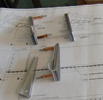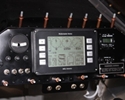


random user submitted photo
High Engine Oil Temps.
34 posts
• Page 4 of 4 • 1, 2, 3, 4
Re: High Engine Oil Temps.
Hi again,
I just thought of a third option to verify that your CHT probes are reporting correctly. Use an infrared laser thermometer. Harbor Freight has some good inexpensive models. Check the temperatures of all the heads vs. what your panel display is showing.
I just thought of a third option to verify that your CHT probes are reporting correctly. Use an infrared laser thermometer. Harbor Freight has some good inexpensive models. Check the temperatures of all the heads vs. what your panel display is showing.
-- Michael
OneX N169XE
author of the 'Flight Data Viewer'
OneX N169XE
author of the 'Flight Data Viewer'
- XenosN42
- Posts: 421
- Joined: Thu Jul 24, 2014 4:45 pm
- Location: PA, USA
Re: High Engine Oil Temps.
Thanks guys. I will work on verifying the accuracy of the CHT probes. Who knows I may get lucky....:-)
CPT Tidy
CPT Tidy
- Cpt.tidy
- Posts: 13
- Joined: Fri Aug 24, 2018 8:58 am
Re: High Engine Oil Temps.
Cpt.tidy wrote:Thanks guys. I will work on verifying the accuracy of the CHT probes. Who knows I may get lucky....:-)
CPT Tidy
I will be applying sensors to my engine today. I picked up one of my CHT probes and it made me start thinking about your problem again.
Do your CHT probes have quick disconnects like the probe shown here?

If so, here are some quick checks you can do to isolate your problem.
1) Remove the upper cowl and make sure you can get to the CHT disconnects.
2) Disconnect and reconnect the suspect probe to make sure it is seated correctly.
3) Convince yourself you can disconnect and reconnect probes while the engine is hot.
If your OK with number 3,
4) Start the engine and run it long enough to get the cylinders up to operating temperature (careful not to overtemp).
5) Verify that your problem still exists. That is, verify that re-seating the probe connector did not solve the problem.
6) Shut the engine down.
If the problem still exists:
The engine will obviously start to cool so you will have to pay attention and move along at a good pace.
7) Disconnect the suspect probe and one other probe (at the quick disconnects), swap the connections and check the instrument.
If the low reading changed to the swap channel you have proven that you do indeed have either a cold cylinder or a bad probe.
If the low reading stayed with the original channel your problem is upstream of the sensor (i.e. a bad harness or an instrument problem).
If you do have a bad probe or a cold cylinder it's time to *really* swap probes to check the sensor. Let the engine cool first ;-)
BTW, it would be good information to know how the instrument responds to an open channel. If you get a chance, disconnect one of the "good" channels and see if the reading drifts to zero or some in between number.
Good Luck,
Wes
Wes Ragle
Onex #89
Conventional Gear
Long Tips
Hummel 2400 w/Zenith Carb
Prince P Tip 54x50
First Flight 06/23/2020
42.8 Hrs. as of 10/30/21
Onex #89
Conventional Gear
Long Tips
Hummel 2400 w/Zenith Carb
Prince P Tip 54x50
First Flight 06/23/2020
42.8 Hrs. as of 10/30/21
- WesRagle
- Posts: 878
- Joined: Fri Jan 05, 2018 12:35 pm
- Location: Weatherford, Tx
Re: High Engine Oil Temps.
XenosN42 wrote:Hi again,
I just thought of a third option to verify that your CHT probes are reporting correctly. Use an infrared laser thermometer. Harbor Freight has some good inexpensive models. Check the temperatures of all the heads vs. what your panel display is showing.
I have been following the oil temp thread and suffice it to say I would not try to get cooling air to the sensor if I had high temps. I would try to heat shield the sensor though.
Now to my point on Michaels comment on using an infrared laser thermometer. While that is a very good idea, using an "inexpensive" model from Harbor Freight can get you in trouble. There is a thing called Spot Size Ratio(SSR) with regard to infrared thermography. A 12:1 rated device can sense a 1-inch circle at a distance of one foot, whereas a 10:1 ratio device achieves the same 1 inch circle at 10 inches, and a wider, less-specific circle of 1.2 inches at a distance of 12 inches. The ideal target area should be at least twice the size of the spot at that distance,[4] with smaller areas relative to distance resulting in less accurate measurement. An infrared thermometer cannot be placed too close to its target, or this proximity causes heat to build up in the thermometer's housing and damages the sensor. Measurement error generally only decreases with too much distance because of the effects of reflectivity and the inclusion of other heat sources within the sensor's field of view. The Harbor Freight model has a 6:1 ratio.
During my working career I was a Certified Level 1 Thermographer and I had(and still have) a fairly expensive Flir Infrared camera which I did use on both my AeroVee and CAMit to verify temps of all of my sensors. It is a great idea Michael but again be careful and understand the limits of inexpensive models.
Loren Sievila
Conventional Gear Onex33
CAMit 2200
Dynon Skyview
Conventional Gear Onex33
CAMit 2200
Dynon Skyview
- lgsievila
- Posts: 158
- Joined: Fri Feb 19, 2016 12:54 am
34 posts
• Page 4 of 4 • 1, 2, 3, 4
Who is online
Users browsing this forum: Google [Bot] and 67 guests







